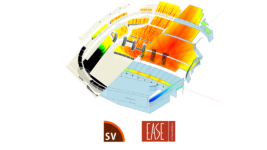THEATRE
22 Nov 2023
WAGNER’S RING CYCLE
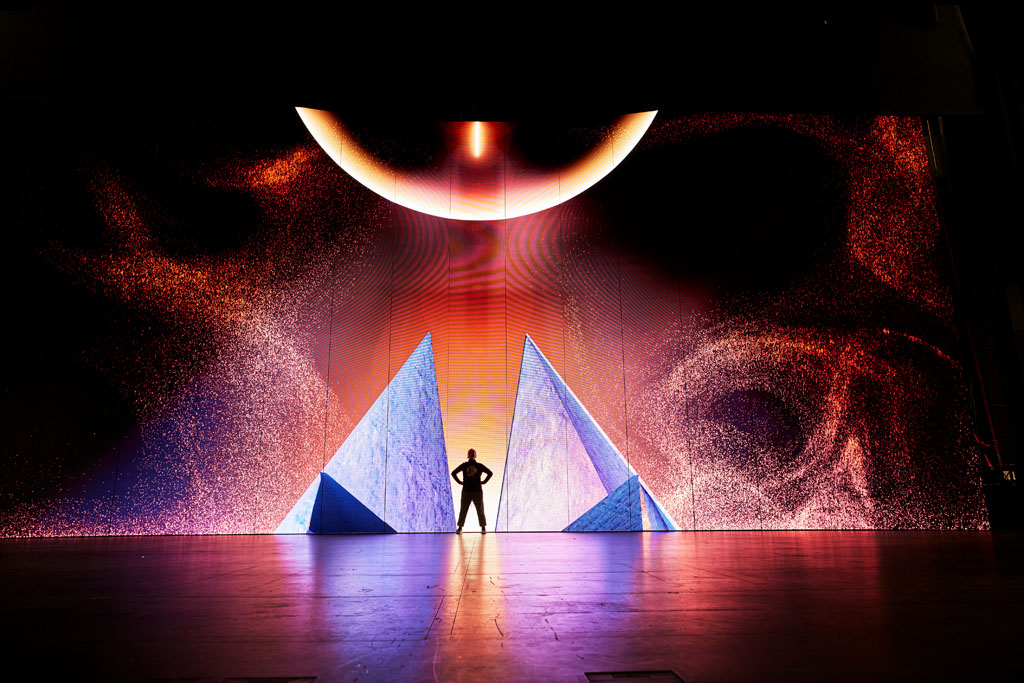
Subscribe to CX E-News
Opera Australia’s Blockbuster Digital Production
“One supreme fact which I have discovered is that it is not willpower, but fantasy and imagination that creates. Imagination is the creative force. Imagination creates reality.” – Richard Wagner
Opera Australia’s the Ring Cycle (Der Ring des Nibelungen), is set to hit the stage of Brisbane’s QPAC Theatre in December of this year. Richard Wagner’s 1874 mammoth opera creation – an epic 15-hour musical journey told across four operas – will be experienced with the incorporation of cutting-edge custom- designed digital images delivered to over 300 square metres of LED screen.
The Ring Cycle’s compelling historical themes and characters move together with futuristic, abstract elements through entire worlds created using digital content. The physical prop pieces even leap to life through digital interaction. The crossover and interaction between physical and virtual reality gives a level of depth to the performance never before experienced by the Ring Cycle audiences.
“Creative possibilities opened up for me,” Director and Production Designer, Chen Shi-Zheng explains. “With the use of new forms of tracking and interactive LED elements, telling a story with moving images makes it come to life. It’s not just a still picture, it makes it look more like a live film, which changes everything.”
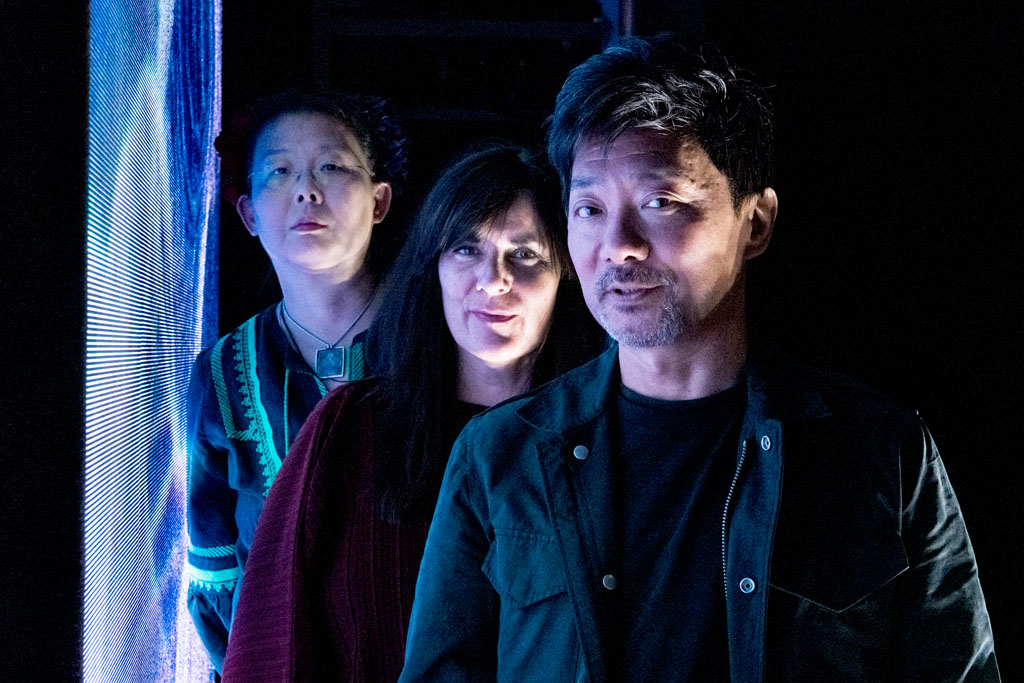
Chen brings an impressive portfolio to OA. He has used video elements in productions for over 20 years and can appreciate it as a tool for creating emotive content. He is also no stranger to grand scale works – most notably, directing Tang Xianzu’s The Peony Pavilion for the Lincoln Centre Festival in 1999. The Peony Pavilion boasts 20 hours of music through 55 scenes with 200 characters (including animals). Certainly not a project for the faint-hearted. Making Chen an ideal candidate to direct the Ring Cycle – the stamina, creative vision and in-depth understanding of how historical significance and themes can be enhanced by technology to “…create emotional content, which helps the music tremendously.”
Perhaps one of the most notable and symbolic creative influences Chen brings to this stage is the incorporation of a 7m tall replica of a 2000-year-old Chinese Bonsai tree. Its blossoms are produced with projected images as well as actual petals, which marry the two techniques beautifully with the essence of magic and movement. Chen’s Bonsai tree not only brings an Eastern influence to an European opera, but it also holds symbolic meaning. “Wotan’s story starts with a tree…it is life, continuing, resurrection, reincarnation, it becomes powerful… it’s a strange creature, people always put a Bonsai in the window and appreciate its beauty. It’s other-worldly”.
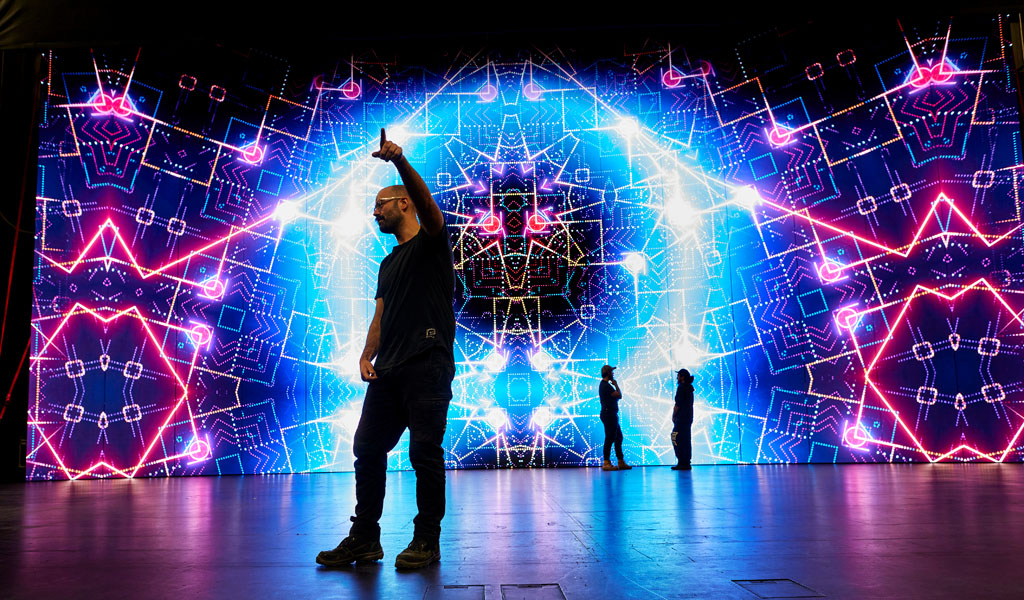
What would Wagner think?
“Wagner would appreciate us pushing the boundaries…he would’ve been the first one jumping out there to write the new software needed to make this creative vision happen.”
Leigh Sachwitz, flora&faunavisions – Digital Content Designer, couldn’t be more on the money. Leigh has been working on this epic production with her team from flora&faunavisions, based in Berlin. They are considered to be one of the leading studios in the world for such work.
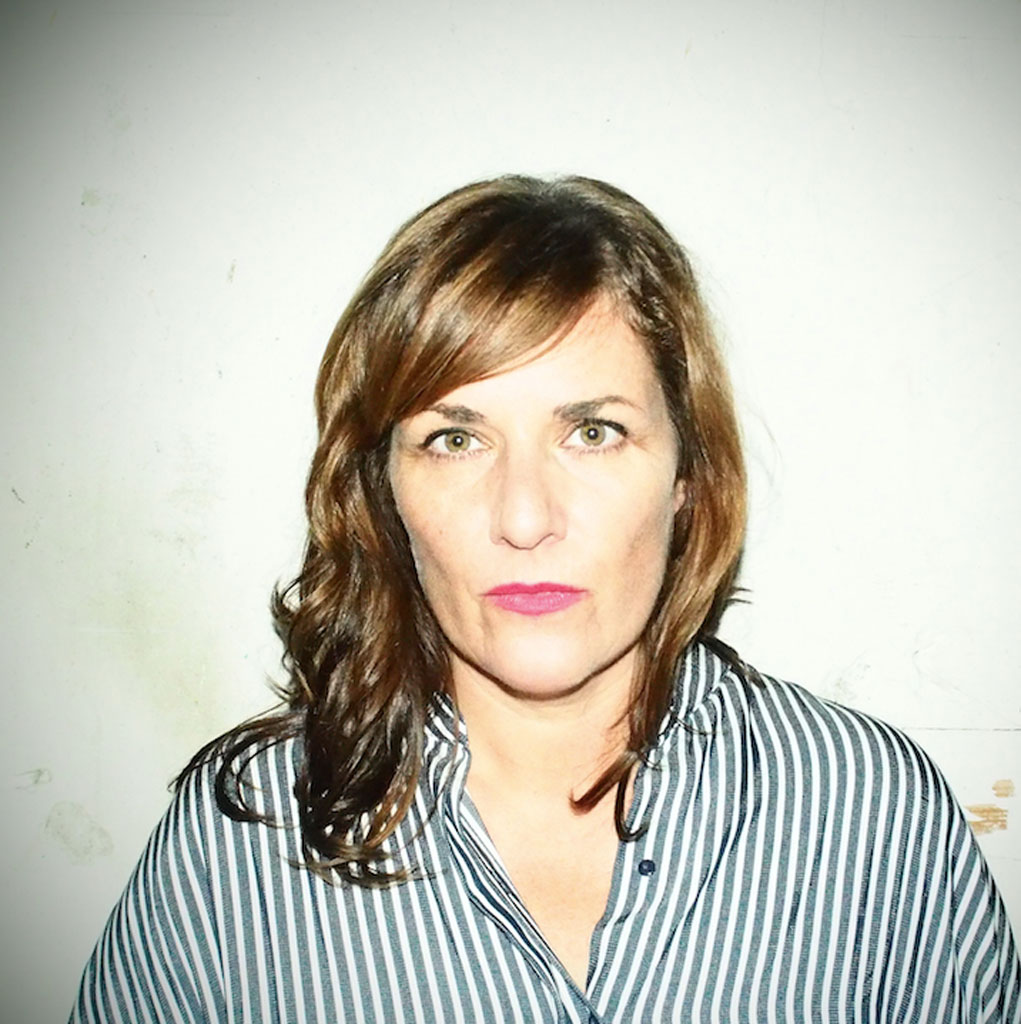
The German composer was well-versed in making innovative ideas happen. As if a 15-hour musical drama marathon wasn’t already pushing the envelope, Wagner commissioned the production of new musical instruments for this work to achieve the tone qualities he couldn’t quite produce with conventional orchestral instruments. The creation of the purpose-built Wagner tuba, bass trumpet and contrabass trombone was, essentially, Wagner writing the “software” needed at the time to make the “show happen”.
Designing the original digital content for a combined 24 LED screens (14 tonnes of 834 individual LED panels) moving, tracking, twisting and flying across the stage is as gargantuan a task as the opera itself. There’s also the lighting, the automations and interactions. “It’s a lot of content, a lot of cues and a lot of integration to get through,” Technical Director, Chris Yates remarks at the OA test build.
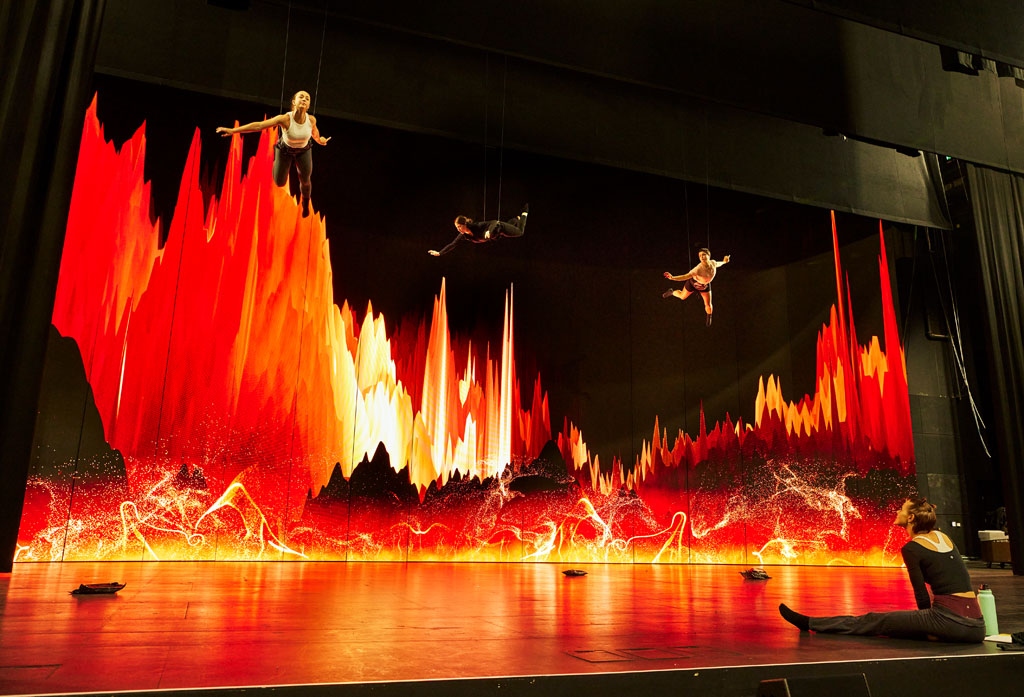
CX caught up with some of the creative minds at the Sydney Coliseum Theatre – West HQ, site of the Ring Cycle’s test build. This particular venue was chosen for the test build as it’s one of few venues in the country with a footprint and facilities similar to that of Brisbane’s QPAC theatre.
So, where do you start?
“It really depends on your DNA and your ethos as a designer. It’s like a painter with a blank canvas – you start with one stroke, then another and another…the most difficult part as an artist is knowing when to stop. To know when you’re finished is the hardest part.” Where there’s an opportunity to create something with no rules, no basis for comparison, no limitations (except for maybe budget, Sachwitz half-jokingly points out), an artist is truly in their element.
Knowing what moments to bring out and when is as crucial as understanding the negative space when it comes to vast visual display. “It’s not about what you see, it’s about what you don’t see. That’s very, very important”, advises Sachwitz, “When considering black space, you have to know how to cut the image, where it’s coming from, how big it is, whether it’s going out to full frame and all those things.”
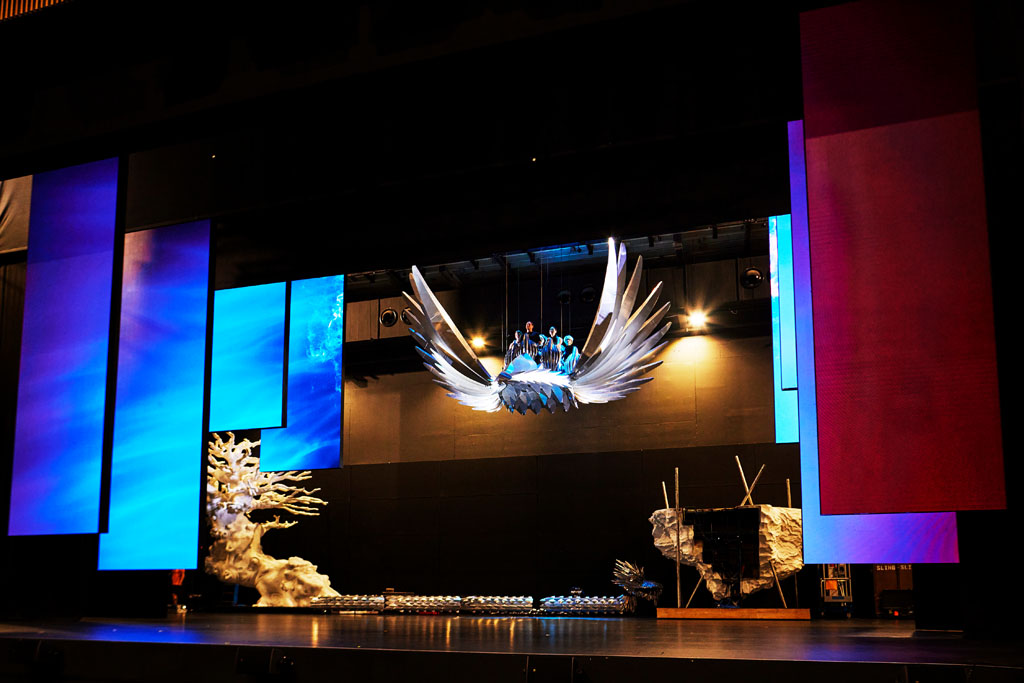
Head of Lighting, Jason Morphett shares his approach: “It’s more manageable to treat this as four shows, but you have to be aware of the overarching principles that cover all four shows of the production. Then you can dial down to the specific needs and systems for each of the four shows, keeping in mind what is ‘global’ and what is ‘specific’. The global forms, the outlines, and the specifics form the details.”
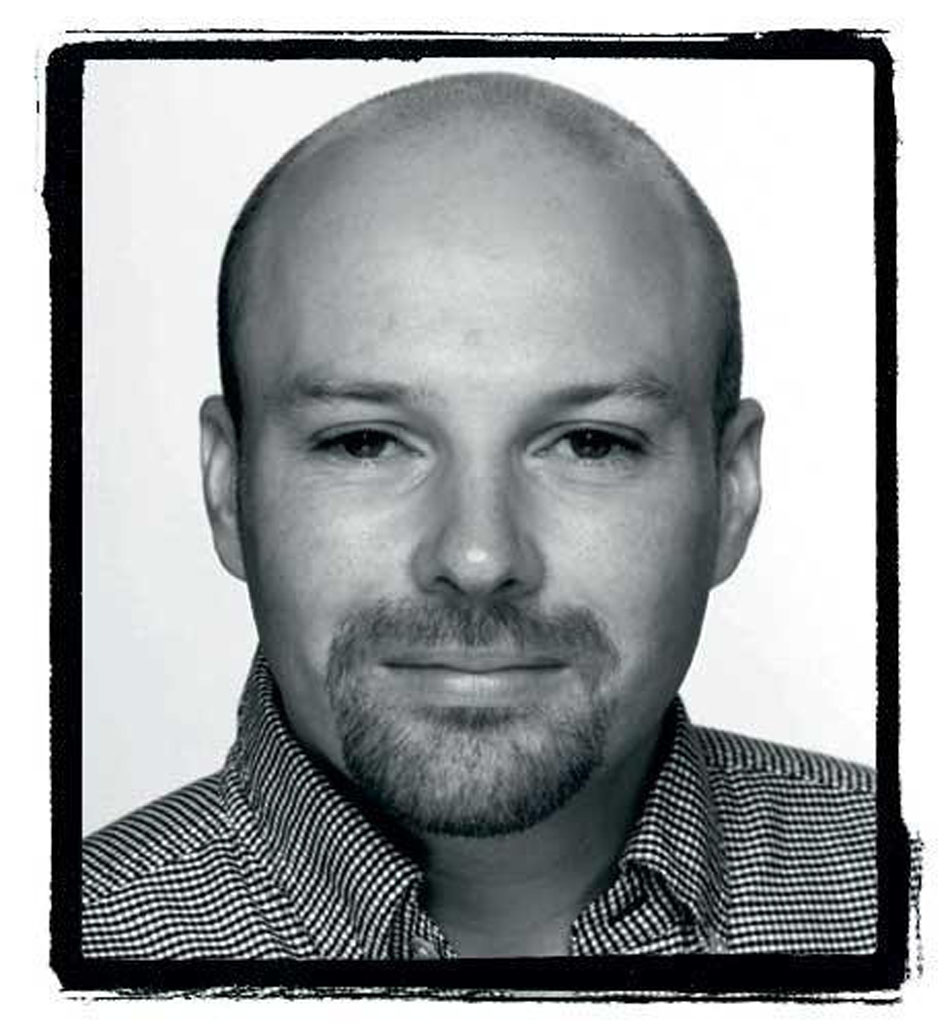
Tools of the trade
Keeping across the right tools and the best piece of software for every application and how it will interact with the equipment is about as big a challenge as the content design and creation itself. The technology available in 2020, when the project first grew legs, is not immune to the ever-evolving tech landscape, which continued to open up more options. Negotiating two cancellations across three years due to the COVID pandemic was not only posing a threat to the viability of the project, but the production was continuing to evolve along the way.
When staging in 2023 finally became a reality for the Ring Cycle, real-time 3D creation tools originally implemented in gaming were now available for other digital design applications, versions of critical design programs received significant upgrades. For example, text-to-image diffusion models, Midjourney and Stable Diffusion, are employed by the digital design team – and it wasn’t until June 2023 that Midjourney gained the ability to zoom out images. Subtle, yet useful changes which can now be utilised.

The images will be cast across an impressive 152sqm of Uniview Tekken 3 LED screen (3.9mm pixel pitch). Media server system disguise gx 2c runs the onstage automation screens and takes the heavy Notch load on the outputs. Notch is a real-time graphics tool for 3D and VFX used in this context for digital interaction of aerialist performers to connect the physical movement of the actors to the visual effects on the screen. In essence, the interaction accentuates and exaggerates the movement of the artists by affecting the visuals on the LED screen. It’s a complex process, requiring three pre-programmed tracks to get all the sequences correct with the performer flying elements. The tracking is done using PSN (PosiStageNet positioning and lighting system) information “…which effectively gives coordinate information for where the pick ups on the aerialists are. Wherever those hooks are, that’s the info being spat out of the Raynok Imperium Automation Console back to the D3 processor, using that to have the D3 manipulate a trail image on the screens in real time with the dancers,” explains Morphett.
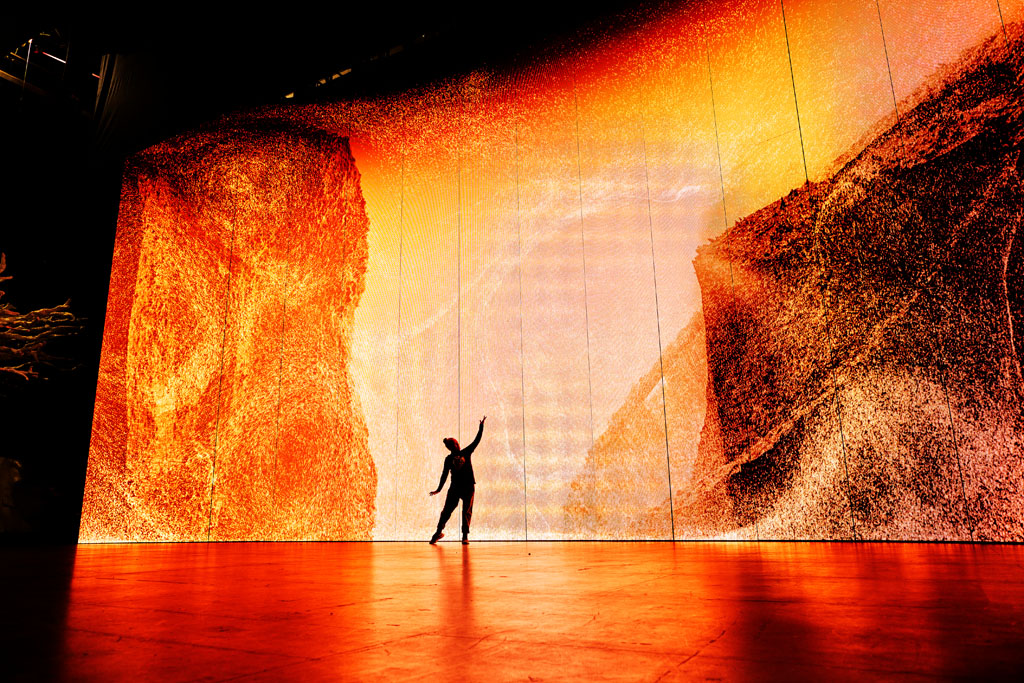
The “fire dancers”, also digitally interactive, are tracked using a Blacktrax vision based tracking system. Eight dancers utilise tracking “beacons” during the Fire Dance to trail fire and smoke along the screens in real-time with the dancers. This information also conveniently translates to the follow spot.
The tracking system, in total, employs a full size Blacktrax server, 25 beacons, 16 IR cameras, three Luminex nodes and one Luminex merge node to track the Uniview Tekken screens and the interactive performers.
Blacktrax is supplemented by Canadian company, CAST Software.
In addition to the above 152 square metres of screen, there’s the additional 162sqm US cyclorama comprised of ROE CB5 T4 frames (5.77mm pixel pitch) built in columns of 10.8sqm individual screens to allow for the guillotine mechanism, all run on a Kinesys motion control system for the vertical flying (up and down) and the Raynok for tracking and rotating. A disguise DX4 media server system outputs to the Cyc.
All LED utilises Brompton processing: four Tessera SX40s and ten XD data distribution units, running 10-bit+ extended bit depth and Dark Magic.
The additional single Tekken panel – 1.0m x 0.5m, for the onstage Ice Palace – has its own battery-powered (DC inverter) Tessera S4 processor and H.264 wireless signal via a Unifi AirFibre system.
Incoming data is tracked by the disguise media server system and an additional disguise VX4 and disguise gx 2c serve as backup.
The AV system is supplied by Big Picture (an NEP Live Events Company). The Notch programming is programmed and designed by flora&faunavisions.
Alongside the visual indulgence of endless LED screen and ‘animated’ real-life actors, are the carefully selected and designed prop pieces, such as that of the aforementioned Bonsai tree, which digitally integrate into their respective scenes, pronouncing their symbolism within the storyline. The tree, a rock of significance, fire dragon, to mention a few, all spring to life with the use of projection mapping. Main and backup Barco UDX 4k32 cinematic projectors mount on the dress circle to cover the proscenium and these onstage purpose-built set pieces. The disguise VX4 also operates as server system for the projection elements.
If digging deep into this production prior to its debut hasn’t already been a spoiler, consider this your alert. The second opera in the Ring Cycle, Die Walküre, is perhaps the most recognisable. Know it or not, you would have heard its triumphant Ride of the Valkyries theme somewhere before – be it on an ad, in a movie, or just playing through your head as you enter a room poised as superhero or super villain. It only seems fitting that the scene incorporates the eight Valkyrie Warriors actually flying in on a huge, metallic Phoenix.

Eight people flying on a prop piece. This certainly expands the workplace health and safety criteria. Which is why OA has outsourced the job to industry professionals in the automation, robotics and lighting application industry, Simple Motion. “The Phoenix is run by Simple Motion with a bespoke controller system. Due to eight people flying on it, it had to be a bespoke company that understands this side of the game. They came with their own winches and motors due to the rules and regulations of flying eight people,” comments Morphett on the custom solution required for this piece.
Morphett’s rational approach towards tackling the lighting for this size and length of production forms the basis of the plan: “All four shows are individual stacks within the same show file. We can use presets from one show in all the shows (global presets) alongside the show-specific presets.” Logical, yet still an enormous logistics exercise for the lighting team.
A traditional lighting rig (around 150 LED movers, according to Morphett), not surprisingly won’t cut it for this production. With so many screen elements constantly changing position, the Ring Cycle’s Lighting Designer, Matt Marshall must exercise enormous flexibility in the design and management of the rig. The challenge posed by the shifting landscape is met with the addition of side lighting and floor lighting, bringing this rig up to nearly 170.
This includes 80 MAC Encore Performance CLDs (the workhorse of the productions), 10 MAC Encore Performance WRMs, 40 MAC Encore Wash CLDs, 10 Aryton Diablo S Profile and 24 Robert Juliat Dalis 860 Cyclights. Nearly two thirds of the lighting is OA inhouse, with the additional provided by Chameleon Touring Systems.
Controlling all this is an ETC Gio lighting console, triggering the D3 processor and all the AV cues. The D3 is then processing and sending out the information. The console is also triggering and operating the Blacktrax tracking system (Blacktrax Information is taken from the Raynok controller and the Kinesys motor system and passed into either the lighting desk or the D3 to be used as positional information for the video).
Also in use is an ETC 5, multiple RC4 wireless dimmers and transmitters and WDMX wireless dimmers and transmitters. MDG Atmos hazer, ZR44 smoke machine, two Glaciator low-smoke generators and two mini fogger small-battery smoke guns are implemented for atmosphere.
The lighting rig is substantial, much like everything else about production, but its purpose serves not as a light show spectacle, but to carefully add enhancement to what’s already displaying. It’s infilling, adding texture and working in conjunction with the other visual elements of the production – essentially following the same “less-is-more” philosophy guiding Sachwitz and her design team to achieve a powerful yet smoothly integrated visual display.
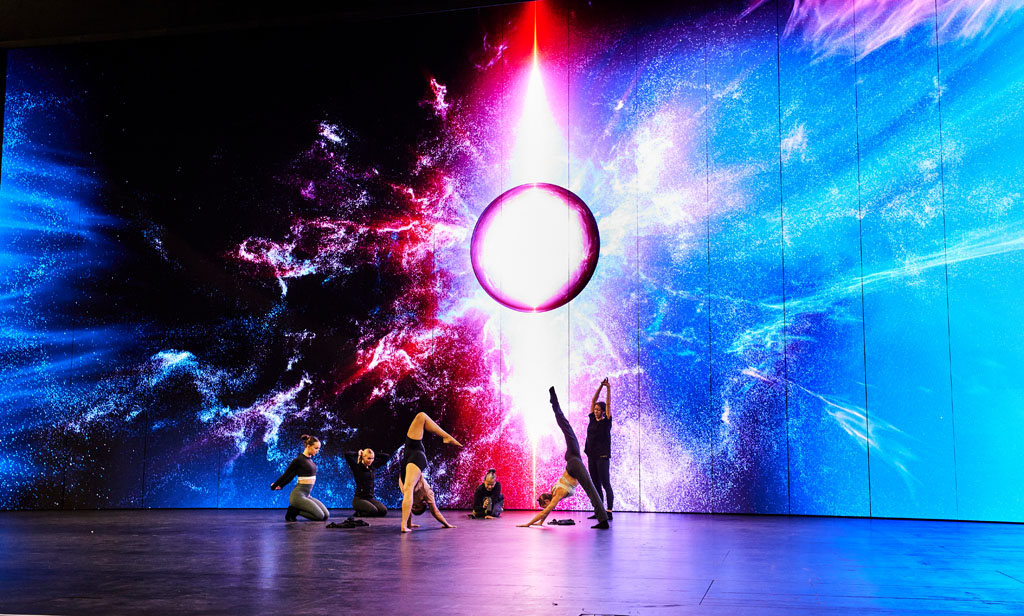
The final act
“You have to look at the stage as an audience member. The biggest success is if everything looks and flows like one vision. If you can achieve the digital imagery, costume, lighting, music, singing, action and interaction all as one experience, it’s a success on both a technical and visual level,” concludes Sachwitz.
Wagner wouldn’t only be appreciative; he would be thrilled. “Gesamtkunstwerk”, which literally translates to “Total Artwork”, is essentially all the elements of a performance integrating and being experienced together as one. Wagner propagated this ideal, and intentional or not, it seems as though he is being channeled by the OA creative team.
It’s safe to say OA will be serving audiences of 2023 the same level of “wow” factor Wagner did way back in 1874. Only, instead of by side-stepping conventional European opera format and introducing new instrumentation, it will be through larger-than-life props, dancing through dazzling graphics in a mixed-reality universe. As Director and Production Designer, Chen Shi-Zheng sums it up, it’s “tribal culture marrying the sci-fi world to create a new vehicle for the Ring.”
Subscribe
Published monthly since 1991, our famous AV industry magazine is free for download or pay for print. Subscribers also receive CX News, our free weekly email with the latest industry news and jobs.

